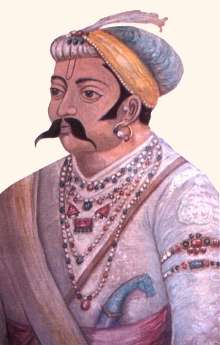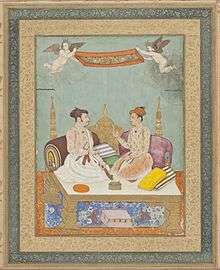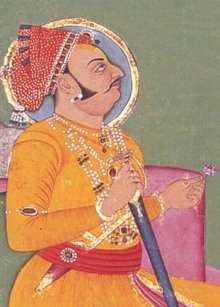Jodhpur State
Jodhpur State also historically known as the Kingdom of Marwar, was a kingdom in the Marwar region from 1226 to 1818 and a princely state under British rule from 1818 to 1947. Its capital was the city of Jodhpur since 1450.
Jodhpur State (1818–1947) Kingdom of Marwar (1226–1581; 1583–1818) | |||||||||
|---|---|---|---|---|---|---|---|---|---|
| 1226–1581 1583–1947 | |||||||||
 Flag
 Coat of arms
| |||||||||
 Jodhpur State in the Imperial Gazetteer of India | |||||||||
| Status |
| ||||||||
| Capital | Jodhpur | ||||||||
| Common languages | Marwari Sanskrit | ||||||||
| Maharaja | |||||||||
• 1226–1273 | Rao Siha (first) | ||||||||
• 1947–1949 | Gaj Singh (last) | ||||||||
| History | |||||||||
• Established | 1226–1581 1583–1947 | ||||||||
| Area | |||||||||
| 1931 | 93,424 km2 (36,071 sq mi) | ||||||||
| Population | |||||||||
• 1931 | 2,125,000 | ||||||||
| |||||||||
| Today part of | Rajasthan, India | ||||||||


.jpg)



Covering an area of 93,424 km2 (36,071 sq mi), Jodhpur State was the largest state under the Rajputana Agency and the third largest state in British India after Jammu and Kashmir State and Hyderabad State. The average revenue of the state was Rs.56,00,000 in 1901.[1] the Maharaja's of Jodhpur originally had a gun salute of 19 guns with 21 personal. However the gun salute was reduced to 17 guns and 21 personal in 1870 due to a quarrel with the Maharana of Udaipur.[2][3] Its last ruler signed the accession to join the Indian Union on 7 April 1949 and the state was formally dissolved on 1 November 1956.[4]
History
The Rathore rulers of the Indian princely state of Jodhpur were of an ancient dynasty established in the 8th century. However, the dynasty's fortunes were made by Rao Jodha, first of the rulers of the Rathore dynasty in Jodhpur in 1459. Out of the 15 rulers that preceded Jodha, 9 died on the battlefield, of them 6 against foreign armies. Jodha's son himself died after a battle in which he saved 140 women from Afghan raiders.[5]
The kingdom remained independent until it was annexed by the Mughal Empire in 1581 after the death of Chandrasen Rathore. It remained under direct Mughal control until Udai Singh was restored to the throne as a vassal and given the title of Raja in 1583. During the late 17th century it was under the strict control of the Mughal Emperor Aurangzeb, but the ruling house of Rathore was allowed to remain semi-autonomous in their territory. During this time Durgadas Rathore struggled to preserve the rathore dynasty and freed Marwar from the Mughal Empire after 31 years of war. In the late 18th and early 19th centuries the kingdom was overrun by the Maratha hordes of Scindia and Holkar. Marwar was financially bankrupt due to heavy tributes exacted by the Marathas and its once renowned army had now thinned down because of internal wars and rebellions by its nobles, forcing its rulers to ask the British for aid. The British had no role in the state's affairs until 6 January 1818, when the Raja at that time, Man Singh, entered into a subsidiary alliance, after which the Rajas of Marwar (or Jodhpur) continued as rulers of a princely state. During the Indian Rebellion of 1857, the Rajput Nobles of Pali under Thakur Kushal Singh Rathore led a rebellion against Raja Takht Singh and the British, however the rebellion was put to an end by the British armies under colonel Holmes after a siege of the Thakurs fort in Auwa.[6] The armies of Jodhpur State fought in World War I for the British. They actively fought in Afghanistan and the Middle-east and scored a series of victories for the British empire. The Jodhpur lancers with the support of the Mysore lancers defeated a large host of Turks and Germans in the Battle of Haifa (1918). Some of the other battles they participated in were the battles of Suez, Gaza, Jordan Valley, Abu Tellul and Megiddo.
Following Indian independence in 1947 Maharaja Hanwant Singh, the last ruler of Jodhpur state, delayed signing the Instrument of Accession to India. He even briefly considered acceding to Pakistan, for Jodhpur shared a border with the new nation and he had been personally given a blank page to write his demands and an assurance of access to sea ports in Pakistan by Muhammad Ali Jinnah. But due to the effective persuasion of Sardar Vallabhbhai Patel and Lord Mountbatten, the Maharaja of Jodhpur agreed to the accession of his state to the new Dominion of India.[7][8]
Rulers of Marwar
The Rathore dynasty of Jodhpur are Rajputs who claim descent from the Rashtrakuta dynasty.[9] On the fall of the Rashtrakuta dynasty they migrated north and formed their kingdom in Kannauj and then in Marwar.[9]
Rulers 1226–1438 (From Pali & Mandore)
| Name | Notes | Reign began | Reign ended | |
|---|---|---|---|---|
| 1 | Rao Siha | He conquered Pali and became the first rao of the Rathore dynasty in Marwar. He died in the battle of Lakha Jhawar (1273) against Sultan Ghaus ud-din Balban. | 1226 | 1273 |
| 2 | Rao Asthan | Conquered Kher from the Gohils and Idar from the Bhils. He died in battle against Jalaludin Khilji. | 1273 | 1292 |
| 3 | Rao Doohad | He conquered more than 140 villages. He was killed in battle against the Parihars. | 1292 | 1309 |
| 4 | Rao Raipal | He avenged his father by killing the ruler of the Parihars. During a famine in Marwar he distributed his own personal grains to the people. | 1309 | 1313 |
| 5 | Rao Kanhapal | He suffered raids from the Turko-Afgan tribes and was killed in action defending his lands. | 1313 | 1323 |
| 6 | Rao Jalansi | He defeated the Sodhas. He took the turban of the Sodha chief to mark his supremacy in the region. | 1323 | 1328 |
| 7 | Rao Chado | 1328 | 1344 | |
| 8 | Rao Tida | He was killed in battle against the sultan of Delhi. | 1344 | 1357 |
| 9 | Rao Kanha Dev | 1357 | 1374 | |
| 10 | Rao Viram Dev | He died in battle against the Johiyas. | 1374 | 1383 |
| 11 | Rao Chandra | He conquered Mandore from the Turks in 1406. He further conquered the areas of Nagaur, Sambhar, Khatu, Nadol and Ajmer. He was killed in battle against Salim Shah of Multhan. | 1383 | 1424 |
| 12 | Rao Kanha | Fought battles with his brothers. Died young in Mandore. | 1424 | 1427 |
| 13 | Rao Ranmal | He consolidated his rule with the help of the Sisodiyas of Mewar. He was later assassinated on the orders of Rana Kumbha. | 1427 | 1438 |
Rulers 1459–1949 (From Jodhpur)
| Name | Notes | Reign began | Reign ended | |
|---|---|---|---|---|
| 1 | Rao Jodha | Fought Rana Kumbha and reclaimed his lands. He later founded the city of Jodhpur and made it his capital. He subjugated the states of Jalore and Bundi and annexed Ajmer, Sambhar and Mohilavati. | 12 May 1438 | 6 April 1489 |
| 2 | Rao Satal | Died from wounds after saving 140 women from Afghan raiders. | 6 April 1489 | March 1492 |
| 3 | Rao Suja | March 1492 | 2 October 1515 | |
| 4 | Rao Biram Singh | Son of Bagha | 2 October 1515 | 8 November 1515 |
| 5 | Rao Ganga | Assisted Rana Sanga in his campaigns against the Sultans of India. | 8 November 1515 | 9 May 1532 |
| 6 | Rao Maldeo | Successfully repelled the invasions of Sher Shah Suri. Called as one of the most potent rulers of Hindustan by Ferishta. | 9 May 1532 | 7 November 1562 |
| 7 | Rao Chandra Sen | He defended his kingdom for nearly two decades against relentless attacks from the Mughal Empire. | 7 November 1562 | 1581 |
| 8 | Raja Udai Singh Mota Raja | He was the father in law of Jahangir and got married his daughter Mani Bai married to him, later on who became parents of Shah Jahan[10] | 4 August 1583 | 11 July 1595 |
| 9 | Sawai Raja Suraj-Mal | 11 July 1595 | 7 September 1619 | |
| 10 | Maharaja Gaj Singh I | The first to take the title Maharaja by himself | 7 September 1619 | 6 May 1638 |
| 11 | Maharaja Jaswant Singh | He fought Aurangzeb in the Battle of Dharmatpur. | 6 May 1638 | 28 November 1678? |
| 12 | Maharaja Ajit Singh | Became Maharaja of Marwar after 25 years of war with Aurangzeb. Durgadas Rathore played a key role in the war. | 19 February 1679 | 24 June 1724 |
| 13 | Raja Indra Singh | Installed in opposition to Maharaja Ajit Singh by Emperor Aurangzeb but unpopluar with people of Marwar | 9 June 1679 | 4 August 1679 |
| 14 | Maharaja Abhai Singh | Defeated Sarbuland Khan and occupied all of Gujarat for a short time. | 24 June 1724 | 18 June 1749 |
| 15 | Maharaja Ram Singh | First reign | 18 June 1749 | July 1751 |
| 16 | Maharaja Bakht Singh | He was the general of the Marwari forces against Sarbuland Khan and defeated him. In the Battle of Gangwana he defeated a combined army of Mughals and Kachwahas. | July 1751 | 21 September 1752 |
| 17 | Maharaja Vijay Singh | First reign | 21 September 1752 | 31 January 1753 |
| 18 | Maharaja Ram Singh | Second reign | 31 January 1753 | September 1772 |
| 19 | Maharaja Vijay Singh | Second reign – Was defeated by Mahadji Scindia and forced to surrender the fort and city of Ajmer. | September 1772 | 17 July 1793 |
| 20 | Maharaja Bhim Singh | 17 July 1793 | 19 October 1803 | |
| 21 | Maharaja Man Singh | Entered into treaty relations with the British on 6 January 1818. | 19 October 1803 | 4 September 1843 |
| 22 | Maharaja Sir Takht Singh | Not in the direct line, but a great-great-great grandson of Ajit Singh. Formerly Regent of Ahmednagar. | 4 September 1843 | 13 February 1873 |
| 23 | Maharaja Sir Jaswant Singh II | Kaisar-i-Hind | 13 February 1873 | 11 October 1895 |
| 24 | Maharaja Sir Sardar Singh | Colonel in the British Indian Army | 11 October 1895 | 20 March 1911 |
| 25 | Maharaja Sir Sumair Singh | Colonel in the British Indian Army | 20 March 1911 | 3 October 1918 |
| 26 | Maharaja Sir Umaid Singh | Lieutenant-General in the British Indian Army | 3 October 1918 | 9 June 1947 |
| 27 | Maharaja Sir Hanwant Singh | Ruler of Marwar (Jodhpur) until accession to the Union of India in 1949; died on 26 January 1952 | 9 June 1947 | 7 April 1949 |
| 28 | (titular) Maharaja Gaj Singh II of Jodhpur | Became head of the House on 26 January 1952 | ||
References
- https://dsal.uchicago.edu/reference/gazetteer/pager.html?objectid=DS405.1.I34_V14_201.gif
- The Administration of Jodhpur State, 1800-1947 A.D. by Nirmala M. Upadhyaya, International Publishers, 1973 p.240
- Gazetteer of the Territories Under the Government of the Viceroy of India p.388
- William Barton, The princes of India. Delhi 1983
- Vyas, Varsha S. (2007). Rajasthan, the Quest for Sustainable Development. New Delhi: Academic Foundation. p. 355.
- Political Awakening and Indian Freedom Movement with Special Reference to Rajasthan pg 28–35
- How did Maharaja of Jodhpur get convinced to be part of Independent India instead of Pakistan?
- Ramachandra Guha, India after Gandhi: The History of the World's Largest Democracy. HarperCollins, 2007
- India: The Peacock's Call by Aline Dobbie p.41
- Jodhpur's Umaid Bhawan: The Maharaja of Palaces, by Aman Nath. Published by India Book House, 2008.
- Jodhpur, Published by [s.l.], 1933.
- Maharaja Man Singh of Jodhpur and His Times (1803–1843 A.D.), by Padmaja Sharma. Published by Shiva Lal Agarwala, 1972.
- The Administration of Jodhpur State, 1800–1947 A.D., by Nirmala M. Upadhyaya. International Publishers, 1973.
- Marwar under Jaswant Singh, (1658–1678): Jodhpur hukumat ri bahi, by Satish Chandra, Raghubir Sinh, Ghanshyam Datt Sharma. Published by Meenakshi Prakashan, 1976.
- Jodhpur, Bikaner, Jaisalmer: Desert Kingdoms, by Kishore Singh, Karoki Lewis. Lustre Press Ltd. 1992.
- The House of Marwar: The Story of Jodhpur, by Dhananajaya Singh. Lotus Collection, Roli Books, 1994. ISBN 81-7436-002-6.
- Modern Indian Kingship: Tradition, Legitimacy & Power in Jodhpur, by Marzia Balzani. Published by James Currey Limited, 2003. ISBN 0-85255-931-3.
- Jodhpur and the Later Mughals, AD 1707–1752, by R. S. Sangwan. Published by Pragati Publications, 2006.
- Jodhpur's Umaid Bhawan: The Maharaja of Palaces, by Aman Nath. Published by India Book House, 2008.
External links

- Official website
